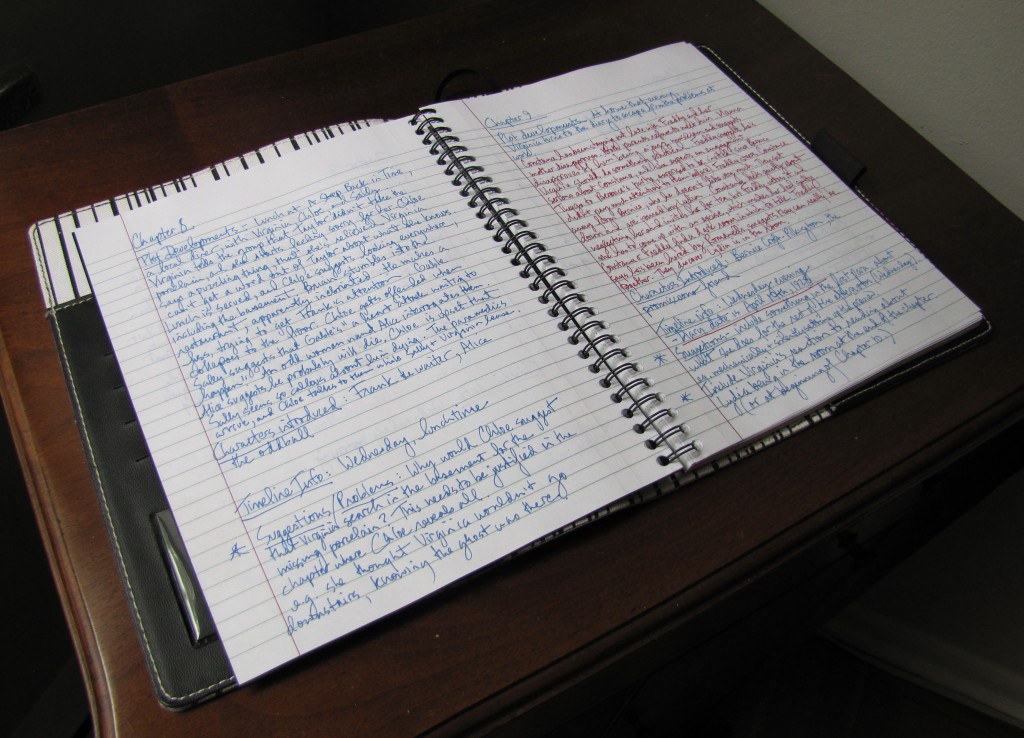I recently finished my third draft of Virginia’s Ghost, the novel I’ve been working on for longer than I can believe. Without a doubt, I’m a putter-inner, not a taker-outer, as my first draft was a bare-bones one and came in at a very slim 30,000 words, while this most recent draft is an impressive (to me, anyway) 61,000 words. I printed it out and discovered that it’s got physical heft if nothing else.
Seeing my book all in one big pile almost made me weak at the knees, and in a reckless moment I almost passed the thing on to one of my trusted editor colleagues. But after rereading it, I realized that it’s almost where I want it to be, so I’m not ready to relinquish it just yet to editorial scrutiny. Almost isn’t nearly good enough for me, nor should it be for any author. I refuse to embarrass myself.
So what’s my next step? Instead of diving directly into Draft 4, I decided to write a summary of each chapter. It’s my way of stepping back into a more objective mode of thinking and ferreting out all the things that need to be fixed: the little timeline glitches, the things that are missing, the events that don’t quite add up or that feel contrived, and the stupid things that sometimes come out of characters’ mouths when you least expect it of them. I’ve written suggestions as to how I’m going to fix these things at the bottom of each chapter summary. The blue writing identifies my main storyline, while the red is a second storyline. I’ve also done some hard-copy edits right on my draft.
But aren’t you supposed to do all the outlining and summarizing stuff at the beginning? Certainly a lot of writing books suggest drawing up an outline well before you write the book, and I often suggest it to clients who seem to be struggling with an unruly plot. But I began writing the book well before I knew very much about outlines, but more importantly, I think that my initial outline probably would have been nearly as skeletal as my first draft. In other words, my writing process doesn’t seem to lend itself to the outline-before-you-write approach. I find myself layering new stories into each successive draft, adding richness and complexity (I hope) to the storylines. There are things going on in the third draft that would have seemed inconceivable to me when I was writing the first or even second draft.
All this reminds me that there are probably as many ways of going about writing a book as there are writers. We each find our own way of getting from that first blank page to the end of that final draft. Our path may be straight, swift, and sure as an arrow heading toward a bull’s eye, or it may be more like that of a meandering, lumbering bear apparently not heading anywhere in particular. The choice is ours, and there is really no right way. The only thing that matters in the end is that the book itself is everything we want it to be.


 Follow
Follow
Who’s going to be your editor, Caroline — I can’t resist asking!
Some years ago, I was at a Chapters-Indigo store in Toronto where I stood raptly listening to an interview between Margaret Atwood and Heather Reisman. Ms. Atwood said at the time that she often begins a new work not having the slightest idea how it would end or the path that the plot might take at any given point. I think you’re on the right track, Caroline. Your characters have come to life and it sounds as though you’re wisely letting them guide you to the end of the story. I recall reading only one scene last year and can still envision so clearly every detail in that basement filled with objects from the past. I’d also like to bring attention to your penmanship – elegant and disciplined! If this is a reflection of your elegantly disciplined state of mind, then Virginia’s Ghost is surely worthy of an introduction by Alan Cumming. Here’s to a soon-completed manuscript!
I feel similarly about outlines. An initial outline creates a skeleton so I know where I’m headed with the plot, but I find it most valuable to create an outline after finishing a few drafts. If written in a cause-and-effect manner, it squeezes out any problems with character motivation, scene structure, etc. For example I might find myself writing, “Protagonist and her friend argue, and protagonist is left wondering–” . . . wait a minute, I forgot to write the protagonist’s reaction! Outlining after the third draft has helped me fix many a problem.
I look forward to reading Virginia’s Ghost!